Abstract
This paper presents a canonical duality theory for solving a general nonconvex constrained optimization problem within a unified framework to cover Lagrange multiplier method and KKT theory. It is proved that if both target function and constraints possess certain patterns necessary for modeling real systems, a perfect dual problem (without duality gap) can be obtained in a unified form with global optimality conditions provided.While the popular augmented Lagrangian method may produce more difficult nonconvex problems due to the nonlinearity of constraints. Some fundamental concepts such as the objectivity and Lagrangian in nonlinear programming are addressed.




Similar content being viewed by others
Notes
Similarly, the canonical dual \(P^d({\varvec{\sigma }}, {{\varvec{\varsigma }}})\) in [12] is concave in \({\varvec{\sigma }}\) and \({{\varvec{\varsigma }}}\), respectively, but not concave in \(({\varvec{\sigma }}, {{\varvec{\varsigma }}}) \in \mathcal{S}^+_c\).
The objectivity is only sufficient but not necessary for the canonical duality theory.
References
Birgin, E.G., Castillo, R.A., Martnez, J.M.: Numerical comparison of augmented Lagrangian algorithms for nonconvex problems. Comput. Optim. Appl. 31, 31–55 (2005)
Chen, Y., Gao, D.Y. : Global solutions to large-scale spherical constrained quadratic minimization via canonical dual approach, to appear in Math Mech Solids (2014)
Ciarlet, P.G.: Linear and nonlinear functional analysis with applications. SIAM, Philadelphia (2013)
Gao, D.Y.: Duality principles in nonconvex system: theory, methods and applications. Kluwer Academic Publishers, Dordrecht (2000)
Gao, D.Y.: Canonical dual transformation method and generalized triality theory in nonsmooth global optimization. J. Glob. Optim. 17, 127–160 (2000)
Gao, D.Y.: Perfect duality theory and complete set of solutions to a class of global optimization problems. Optimization 52, 467–493 (2003)
Gao, D.Y.: Nonconvex semi-linear problems and canonical duality solutions, in Advances in Mechanics and Mathematics II. In: Gao, D.Y., Ogden R.W. (eds.), pp. 261–311. Kluwer Academic Publishers (2003)
Gao, D.Y.: Canonical duality theory: theory, method, and applications in global optimization. Comput. Chem. 33, 1964–1972 (2009)
Gao, D.Y.: Canonical duality-triality: Unified understanding bifurcation, chaos, and NP-hard problems in complexsystems. To appear in Int. J. Bifurcation Chaos
Gao, D.Y., Latorre, V., Ruan, N.: Advances in canonical duality theory, Volume I and II: special issues of Mathematics Mechanics Solids (2015)
Gao, D.Y., Ruan, N., Latorre, V.: Canonical duality-triality: Bridge between nonconvex analysis/mechanics and global optimization in complex systems. In: Advances in canonical duality theory. special issues of Mathematics Mechanics Solids arxiv.org/pdf/1410.2665v2.pdf (2014)
Gao, D.Y., Ruan, N., Sherali, H.D.: Solutions and optimality criteria for nonconvex constrained global optimization problems. J. Glob. Optim. 45, 473–497 (2009)
Gao, D.Y., Sherali, H.D.: Canonical duality: Connection between nonconvex mechanics and global optimization. In: Advances in Application Mathematics and Global Optimization. pp 249–316. Springer (2009)
Gao, D.Y., Strang, G.: Geometric nonlinearity: potential energy, complementary energy, and the gap function. Quart. Appl. Math. 47, 487–504 (1989)
Gao, D.Y., Wu, C.Z.: On the triality theory for a quartic polynomial optimization problem. J. Ind. Manag. Optim. 8(1), 229–242 (2012)
Gao, D.Y., Wu, C.: On the triality theory in global optimization, preprint available at, http://arxiv.org/abs/1104.2970 (2011)
Gao, D.Y., Yang, W.C.: Minimal distance between two non-convex surfaces. Optimization 57, 705–714 (2008)
Gao, T.K.: Complete solutions to a class of eighth-order polynomial optimization problems. IMA J. Appl. Math (2013). doi:10.1093/imamat/hxt033
Glowinski, R.: Augmented Lagrangian Methods: applications to the numerical solution of boundary-value problems, Elsevier Science (2000)
Lagrange, J.L.: Mecanique analytique. Courcier (1811), reissued by Cambridge University Press, 2009
Latorre, V., Gao, D.Y.: Canonical dual solution to nonconvex radial basis neural network optimization problem. Neurocomputing 134, 189–197 (2013)
Marsden, J.E., Hughes, T.J.R.: Mathematical foundations of elasticity, Prentice-Hall (1983)
Morales-Silva, D., Gao, D.Y.: On the minimal distance between two surfaces, http://arxiv.org/abs/1210.1618 (2012)
Nocedal, J., Wright, S. J.: Numerical optimization (2nd edition). Springer (2006)
Powell, M.J.D.: The Lagrange method and SAO with bounds on the dual variables. Optim. Methods. Softw. 29, 224–238 (2013)
Ruan, N., Gao, D.Y.: Global optimal solutions to a general sensor network localization problem. Perform. Eval. 75–76, 116 (2014)
Tröltzsch, A.: A sequential quadratic programming algorithm for equality-constrained optimization without derivatives, Optim. Lett. (2014)
Voisei, M.D., Zalinescu, C.: Some remarks concerning Gao-Strang’s complementary gap function. Appl. Anal. 90, 1111–1121 (2010)
Voisei, M.D., Zalinescu, C.: Counterexamples to some triality and tri-duality results. J. Glob. Optim. 49, 173–183 (2011)
Wang, Z.B., Fang, S.C., Gao, D.Y., Xing, W.X.: Canonical dual approach to solving the maximum cut problem. J. Glob. Optim. 54, 341–352 (2012)
Zhang, J., Gao, D.Y., Yearwood, J.: A novel canonical dual computational approach for prion AGAAAAGA amyloid fibril molecular modeling. J. Theor. Biol. 284, 149–157 (2011)
Acknowledgments
This research was supported by US Air Force Office of Scientific Research under the grant AFOSR FA9550-10-1-0487. Comments and suggestions from two anonymous referees are sincerely acknowledged.
Author information
Authors and Affiliations
Corresponding author
Rights and permissions
About this article
Cite this article
Latorre, V., Gao, D.Y. Canonical duality for solving general nonconvex constrained problems. Optim Lett 10, 1763–1779 (2016). https://doi.org/10.1007/s11590-015-0860-0
Received:
Accepted:
Published:
Issue Date:
DOI: https://doi.org/10.1007/s11590-015-0860-0



